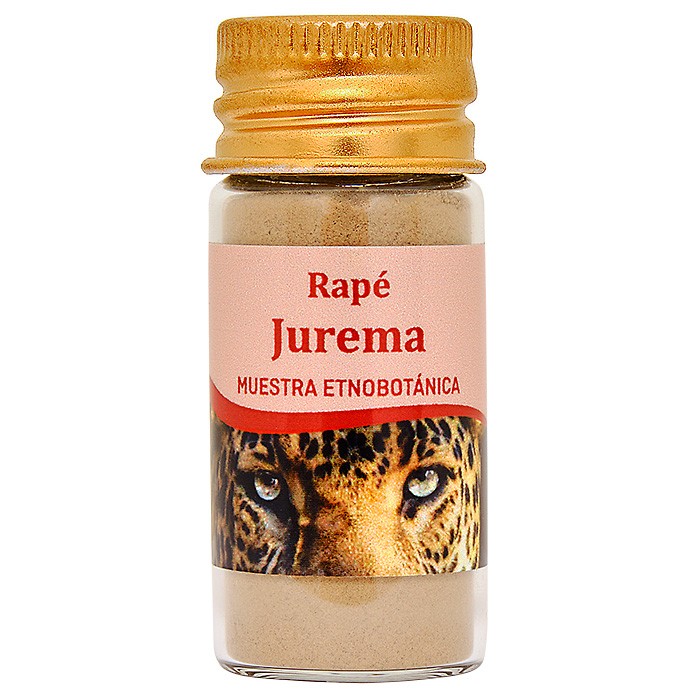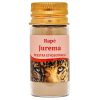Rapé Jurema
26,00€
Rapé Jurema contains a mixture of Mapacho de Sabia and Mapacho de Arapirca, ashes of Tsunu and Jurema Preta.
Jurema Preta or Mimosa Hostilis is a plant used in indigenous ceremonies in Northeast Brazil. It grows in the northeastern savanna ecosystem and belongs to the acacia family. It is a true spectacle with its beautiful flowers that flutter in the wind like white plumes.
It is also used for its properties as a cell regenerator, bacteriostatic, antiseptic, analgesic, healing and regenerating.
Jurema Tree
Taxonomy
Known in Mexico as tepezcohuite, it is the same plant that in Brazil is known as Jurema (Mimosa hostilis).
Other common names are: Jurema preta, jurema negra, ajucá, espineiro (Brazil); tepescohuite (Mexico), cabrero, charcoal, carbonal.
It is a deciduous species, which flowers and bears fruit in the relatively driest time of the year, when it does not have foliage.
It is a very abundant thorny scrub in Mexico (Baja California, Oaxaca and the coast of Chiapas), Central America, the plains of Venezuela and in the arid plains of eastern Brazil: Pernambuco, Minas Gerais and Bahia, where others are also called “jurema”. Mimosa species such as the white jurema (Mimosa verrucosa).
In Mexico it is also called the skin tree, because its bark has important antimicrobial, analgesic and cell regenerating properties.
Mimosa hostilis has white flowers, while Mimosa verrucosa flowers are pink. Mimosa hostilis never has yellow or pink flowers.
History
It was recently recognized that the Mexican Mimosa tenuiflora, described botanically in 1810, is the same species as the Brazilian Mimosa hostilis.
The Mayans of Mexico in pre-Hispanic times called it “Tepezcohuite”. According to Cabrera’s Dictionary of Aztecisms (1975), the word Tepezcohuite comes from the Nahuatl words tepetl (Hill) and cuahuitl (Tree), “tree of the hill.”
The name “skin tree” also became popular in Mexico, which according to Genis (1987), comes from the Nahuatl word tepexohuitztli.
In addition, it is called tepuscuahuitl, which means “iron or metal tree” alluding to the hardness of its wood.
The root bark contains between 0.25% to 4.5% DMT (N,N-dimethyltryptamine) of the dry weight of its root bark.
The bark of the trunk is sold in the markets of Mexico for its applications in popular medicine. On the other hand, the indigenous people of Brazil who make “vinho da jurema” only use the bark of the root.
The effectiveness of tepezcohuite could be tested by two tragic events that occurred in Mexico during the eighties, and massively affected the population.
In November 1984 it was used to treat hundreds of injured people suffering from severe skin burns caused by an unfortunate gas explosion.
Secondly, in 1985, it was used to treat the wounds of earthquake victims.
In both cases, it was used massively with very satisfactory results in the reconstruction of the epidermis, as well as in repigmentation.
Mayans
Considered a sacred tree, Jurema was used by the Mayans as a cure for skin diseases, as a cell regenerator and for the treatment of injuries; It was popularly known as “the tree whose shell is made into powder that heals wounds.”
They used tepezcohuite by applying the powder of its bark on wounds and especially burns, to calm the pain and greatly accelerate their healing, even preventing the appearance of scars.
Jurema Drink
Jurema is a shrub widely used as an analogue of ayahuasca, from whose root the “jurema drink” or “vinho da jurema” is obtained, used in rituals and ceremonies.
Its preparation generally consists of macerating or infusing the leaves in water or alcohol.
Jonathan Ott verified in 1998 that after twenty minutes of drinking Jurema wine, a DMT-type visionary effect is noticeable for about two hours. However, it is known that Dimethyl Tryptamine (D.M.T.) is inactive orally.
It also lacks substances that inhibit the human enzyme Mono Amino Oxidase (MAOIs). For all these reasons, it is assumed that jurema must have some type of orally active tryptamine, yet to be discovered.
Juremahusca drink
In the 1990s, researchers specialized in psychoactive experiments created Juremahusca, a drink analogous to Ayahuasca composed of a mixture of Jurema and Syrian Rue seeds (Peganum harmala), native to North Africa.
The bark of the jurema root usually has 0.5 to 1% D.M.T, while the leaves of chakruna (Psychotria viridis) contain 0 to an average of 0.20% DMT.
In some root barks of Mimosa hostilis mexicana, a much higher DMT content has been found, between 1% and 11% (Ott 2001). The bark of the trunk contains much lower levels of DMT, as do the leaves.
Caution should be taken with both the leaves and the trunk, as they may contain mimosine, a poisonous substance.


